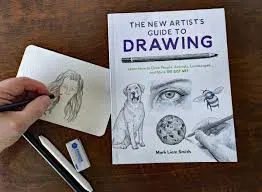
A Comprehensive Guide for Artists, selling artwork can be a rewarding way to turn a passion into profit. Whether you’re a painter, illustrator, digital artist, or photographer, there’s a growing market for original and unique pieces of art. With the rise of online platforms and marketplaces, selling your artwork has become easier than ever, allowing you to reach a global audience from the comfort of your home. In this guide, we’ll explore how to sell your artwork, strategies to maximize your earnings, and tips to ensure your artistic career flourishes in today’s competitive market.

A Comprehensive Guide for Artists Why Sell Your Art?
Selling artwork is not only a way to make money, but it’s also an opportunity to share your creativity with the world. Here are a few reasons why artists should consider selling their work:
- Financial Independence: Selling your artwork provides a potential source of income, whether as a side hustle or a full-time job.
- Global Audience: With online platforms, artists can showcase their work to a global audience, breaking down the barriers of traditional art galleries.
- Creative Fulfillment: Seeing your art appreciated by others can be incredibly rewarding. When you sell your artwork, you build connections and contribute to a larger cultural conversation.
- Brand Growth: Selling your work helps you grow your brand as an artist, potentially leading to more opportunities like commissions, collaborations, or teaching.
Steps to Successfully Sell Your Artwork
- Create High-Quality Artwork
Before diving into selling your artwork, it’s crucial to ensure that your pieces are of the highest quality. Whether you’re working in traditional media (like painting or sculpture) or digital formats, the artwork should reflect your skills, creativity, and unique artistic voice. Buyers are attracted to original and innovative work, so focus on producing pieces that stand out from the crowd.
- Consistency: Ensure your portfolio showcases a consistent style or theme. While you can explore different artistic expressions, having a recognizable style helps in building a brand identity.
- Attention to Detail: Pay attention to the quality of your materials (paints, brushes, canvas, digital tools) and the finishing of each piece. Well-crafted artwork increases your chances of making a sale.
- Build an Online Portfolio
In today’s digital age, having an online presence is essential for any artist looking to sell their work. Building a website or online portfolio allows you to showcase your art in a professional and organized way. Here’s what to include in your portfolio:
- Professional Photography: High-quality images of your artwork are crucial. Make sure each piece is photographed in good lighting with clear, sharp images that accurately represent the colors and textures of your work.
- Detailed Descriptions: Provide detailed information about each piece, including dimensions, materials used, and any relevant backstory or inspiration. This can help buyers connect with your work on a deeper level.
- Categories: Organize your artwork by categories (e.g., paintings, drawings, digital art) to make it easy for visitors to navigate your portfolio.
- Contact Information: Make sure potential buyers can easily get in touch with you for inquiries or commissions. Include links to your social media profiles as well.
You can create an online portfolio using platforms like WordPress, Squarespace, or Wix. Alternatively, sites like Behance and DeviantArt are excellent for artists who want to showcase their work without building a website from scratch.
- Choose the Right Selling Platforms
There are a variety of online platforms where you can sell your artwork. Depending on your niche, medium, and audience, you can choose the platforms that best suit your needs. Here are some popular options:
- Etsy: Etsy is one of the most popular platforms for selling handmade and unique items, including art. It’s an excellent place for artists who create original paintings, prints, or other handmade works. With millions of active buyers, Etsy provides an easy-to-use marketplace that caters specifically to creators.
- Society6: This platform allows artists to sell their work as prints, on home decor, and even on apparel. Society6 takes care of the printing and shipping, making it easy for artists to monetize their designs without managing inventory.
- Redbubble: Like Society6, Redbubble offers print-on-demand services. Artists can upload their designs and sell them on a wide variety of products, such as t-shirts, stickers, phone cases, and more.
- Artfinder: Artfinder is an online marketplace specifically for original artwork, including paintings, photography, and sculpture. It’s ideal for artists who want to sell high-quality original pieces to serious collectors.
- Saatchi Art: Saatchi Art is an online gallery that connects artists with buyers looking for original fine art. It offers an opportunity for artists to reach an international audience and is known for showcasing a wide range of art styles and mediums.
Selling platforms can take a commission from each sale, so be sure to read the terms and pricing structure before choosing the right one for your business.
- Research Similar Artists: Look at what other artists with similar styles, experience, and mediums are charging for their work. Platforms like Etsy, Saatchi Art, or Society6 can give you an idea of current market trends.
- Cost of Materials and Time: Factor in the cost of your materials and the time spent creating each piece. Additionally, if you’re selling prints or reproductions, consider the costs of production, shipping, and platform fees.
- Perceived Value: Pricing is often about perceived value. If your artwork is in high demand or you have a growing reputation, you can command higher prices.
- Offer Different Price Points: To appeal to a wider range of buyers, consider offering different products at various price points. For example, you can sell original pieces at a premium while offering prints or digital downloads at lower prices.
- Promote Your Artwork on Social Media
Social media is a powerful tool for promoting your artwork, connecting with potential buyers, and building a loyal audience. Platforms like Instagram, Pinterest, Facebook, and Twitter allow artists to reach a broad audience and showcase their work in a visually engaging way.
- Instagram: Instagram is especially popular among artists due to its focus on visual content. Use Instagram to share images of your artwork, behind-the-scenes content, time-lapse videos, and process updates. Engage with your followers by using relevant hashtags (#art, #artistsoninstagram, #artforsale), replying to comments, and collaborating with other artists.
- Pinterest: Pinterest is another great platform for showcasing your work, especially if you create DIY art or crafts. Pin your artwork and link back to your online store or portfolio.
- Facebook: Create a dedicated Facebook page for your art business where you can post updates, promotions, and links to your work. Join art-related groups to network with other artists and potential buyers.
- TikTok: Short-form video content is booming, and TikTok is a great platform for showcasing the creative process. Share quick clips of you working on a piece, giving tutorials, or explaining the meaning behind your work.
Consistent posting and interaction with your audience can help you grow your online presence and drive traffic to your selling platforms.
- Leverage Online Art Communities
In addition to social media, joining online art communities can help you network with fellow artists, gain inspiration, and find potential buyers. Websites like DeviantArt, Behance, and ArtStation allow artists to display their portfolios, receive feedback, and connect with other creatives.
These platforms can be useful for showcasing your work to other professionals, building relationships with galleries or art collectors, and gaining recognition within the art community.
- Offer Custom Art and Commissions
Many buyers are interested in purchasing custom artwork tailored to their specific needs. By offering commissions, you can provide a personalized service that caters to individual clients, increasing your chances of making a sale.
To offer commissions, create clear guidelines on your pricing, turnaround time, and the process for requesting custom work. Be transparent about your terms and ensure you’re comfortable with the client’s requirements before starting any project.
Promote your commission services on your social media profiles, website, and online marketplaces. Make it easy for potential clients to understand how to request custom work and what they can expect in terms of cost and delivery.
- Attend Virtual Art Shows and Markets
In addition to selling your artwork online, consider attending virtual art shows and markets. Many online platforms offer virtual spaces where artists can showcase and sell their work to interested buyers.
- Virtual Art Galleries: Online galleries host virtual exhibitions where collectors can view and purchase art from the comfort of their homes. Many of these platforms allow artists to upload high-quality images of their work, provide descriptions, and interact with buyers.
- Online Art Markets: Platforms like Etsy and other artist-focused marketplaces host virtual events and promotions, giving you an opportunity to reach new customers.
Participating in virtual art shows can help you gain visibility and attract collectors who may not have discovered your work otherwise.
Conclusion
Selling your artwork online can be a highly rewarding way to share your creativity while earning a sustainable income. By building a strong online presence, leveraging social media, and choosing the right selling platforms, you can reach a global audience and sell your art to people who appreciate your talent.
For more ideas on how to make money from your creative skills, explore this helpful guide, which provides insights into selling art and other online business opportunities.







